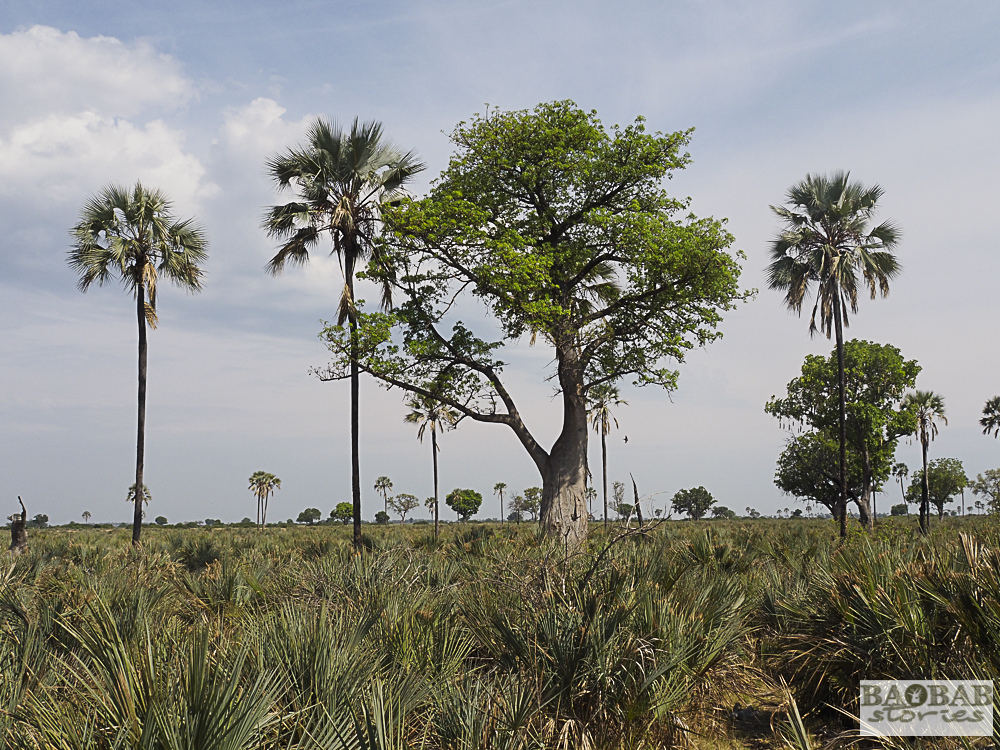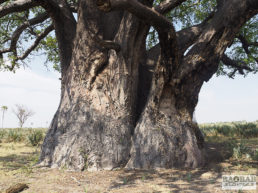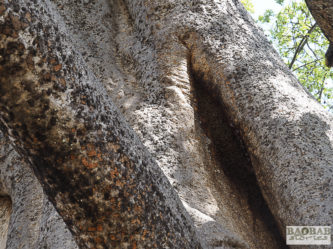
Ancient Baobab Tree, Moremi Game Reserve, Botswana
The November sun burns down intensely from the sky. Temperatures reach 40° C and more in the shade during the day. Even at night no cooling down is to be expected. All creatures are desperately awaiting rain, which simply does not seem to come this year. We are on a game drive in an open all-terrain vehicle in the famous Moremi Game Reserve in Botswana.
Approaching an ancient baobab
Full of expectation we approach one of the giants of the savannah – here this term truly applies. The giant stretches its green branches expectantly towards the sky, literally outshining all the other plants around it: an old baobab tree in full leafy garb. It has not yet given up hope of rain. As every season it sprouts its leaves before the clouds open their floodgates. With this feature it is well equipped and does not waste a drop of precious water. The leaves help the tree to absorb as much precious liquid as possible during the short phase of the rains.

Baobab with mesh wire, Moremi Game Reserve, Botswana
Mesh wire protects baobabs
But something is different with this tree: the giant’s thick trunk is partially wrapped in mesh wire. I wonder what this is all about. The explanation is simple: the fence protects the baobab, says our safari guide Steve. It is no secret that elephants love eating baobabs – why should it be different with this one? On closer inspection, I see traces of previous elephant attacks under the fence. The bark of the old tree is covered with thick scars. They bear witness of the struggles for survival the tree has fought for hundreds of years.
Guide explains why mesh wire works
Steve has been working at Tubu Tree Camp for many years. He tells us that no elephants have attacked the tree since the mesh wire fence was put up. The elephants do not know the “strange” cover of the baobab and therefore stay away from it. Covering tree trunks seems to work – even in this temporarily very dry reserve.
However, while circling around the tree several times I spotted a colony of wild bees that had settled down in one of the larger cavities. Elephants do not like the sound of buzzing bees. Therefore, a combination of the strange fence and the humming of the bees could be responsible for the deterrence of the elephants.

Safari Guide Steve, Tubu Tree Camp, Moremi Game Reserve, Botswana
Protecting baobabs is not always easy – as pachyderms are very clever!
Elsewhere, people are more concerned about the fate of baobabs – for example in Gonarezhou National Park in Zimbabwe. There, the pachyderms have hit the trees particularly hard due to food shortages and reduced space. The park administration tried to protect the baobabs with walls and by putting sharp stones around the trees – with only limited success.

Elephants, Okavango Delta, Botswana
Why do elephants attack baobabs at all?
But why do such attacks on baobabs occur at all? Well, the two giants often share the same natural habitat which is shrinking. Growing populations are fuelling hunger for land and pushing back natural areas. Baobabs on agricultural land often fall victim to deforestation. In national parks or other protected areas, baobabs are a favourite food of elephants. Overgrazing occurs as the latter have to adapt more and more to tightly defined park boundaries with reduced habitats. They can no longer move to other grazing grounds. The baobab trees suffer particularly during dry years, as they usually still store water in their trunks and branches. As a result of natural water sources falling dry the elephants like to chew on baobab wood. Climate change plays its part in adding pressure on natural habitats. Especially when rainy seasons shift or the rain stops falling altogether.

Young Baobab, Moremi Game Reserve, Botswana
Gigantic project KAZA TFCA: for a bright future
But there is reason for hope created by a gigantic initiative in the southern African region. The Moremi Game Reserve covers an area of 4,871 km² and is the oldest game reserve in Botswana. That sounds like a lot of space – but for herds of huge mammals such as elephants it is not. Nowadays the animals are no longer restrained to the game reserve. They benefit from a much larger conservation area, which was created in 2011: the Kavango-Zambezi Transfrontier Conservation Area (KAZA TFCA).
Nature Conservation on 500.000 km²
This transnational conservation area covers over 500,000 km² and crosses five national borders. In this large-scale project, the governments of Angola, Botswana, Namibia, Zambia and Zimbabwe agreed on a joint strategy for the protection of their natural resources. The Moremi Game Reserve is not only located in the heart of the Okavango Delta, but also in the middle of this extraordinary nature conservation project with its diverse protection schemes and adapted zones of usage. As a result, elephants once again have the opportunity to migrate along their old, traditional migration routes to new grazing grounds. This brings relief for the animals and for the flora on which they live.








One of the main advantages of having a wire fencing is that it can be considerably less costly than building a concrete wall, or even using other materials like glass or PVC
Hi Janet, thank you for your comment, yes, lower cost is a crucuial factor in deciding which material to use for protecting baobabs in the wild…